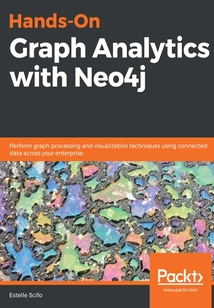舉報 

會員
Hands-On Graph Analytics with Neo4j
最新章節(jié):
Other Books You May Enjoy
Neo4jisagraphdatabasethatincludespluginstoruncomplexgraphalgorithms.Thebookstartswithanintroductiontothebasicsofgraphanalytics,theCypherquerylanguage,andgrapharchitecturecomponents,andhelpsyoutounderstandwhyenterpriseshavestartedtoadoptgraphanalyticswithintheirorganizations.You’llfindouthowtoimplementNeo4jalgorithmsandtechniquesandexplorevariousgraphanalyticsmethodstorevealcomplexrelationshipsinyourdata.You’llbeabletoimplementgraphanalyticscateringtodifferentdomainssuchasfrauddetection,graph-basedsearch,recommendationsystems,socialnetworking,anddatamanagement.You’llalsolearnhowtostoredataingraphdatabasesandextractvaluableinsightsfromit.Asyoubecomewell-versedwiththetechniques,you’lldiscovergraphmachinelearninginordertoaddresssimpletocomplexchallengesusingNeo4j.Youwillalsounderstandhowtousegraphdatainamachinelearningmodelinordertomakepredictionsbasedonyourdata.Finally,you’llgettogripswithstructuringawebapplicationforproductionusingNeo4j.Bytheendofthisbook,you’llnotonlybeabletoharnessthepowerofgraphstohandleabroadrangeofproblemareas,butyou’llalsohavelearnedhowtouseNeo4jefficientlytoidentifycomplexrelationshipsinyourdata.
目錄(120章)
倒序
- 封面
- 版權(quán)信息
- About Packt
- Why subscribe?
- Contributors
- Preface
- Section 1: Graph Modeling with Neo4j
- Graph Databases
- Graph definition and examples
- Moving from SQL to graph databases
- Neo4j – the nodes relationships and properties model
- Understanding graph properties
- Considerations for graph modeling in Neo4j
- Summary
- Further reading
- The Cypher Query Language
- Technical requirements
- Creating nodes and relationships
- Updating and deleting nodes and relationships
- Pattern matching and data retrieval
- Using aggregation functions
- Importing data from CSV or JSON
- Measuring performance and tuning your query for speed
- Summary
- Questions
- Further reading
- Empowering Your Business with Pure Cypher
- Technical requirements
- Knowledge graphs
- Graph-based search
- Recommendation engine
- Summary
- Questions
- Further reading
- Section 2: Graph Algorithms
- The Graph Data Science Library and Path Finding
- Technical requirements
- Introducing the Graph Data Science plugin
- Understanding the importance of shortest path algorithms through their applications
- Dijkstra's shortest paths algorithm
- Finding the shortest path with the A* algorithm and its heuristics
- Discovering the other path-related algorithms in the GDS plugin
- Optimizing processes using graphs
- Summary
- Questions
- Further reading
- Spatial Data
- Technical requirements
- Representing spatial attributes
- Creating a geometry layer in Neo4j with neo4j-spatial
- Performing spatial queries
- Finding the shortest path based on distance
- Visualizing spatial data with Neo4j
- Summary
- Questions
- Further reading
- Node Importance
- Technical requirements
- Defining importance
- Computing degree centrality
- Understanding the PageRank algorithm
- Path-based centrality metrics
- Applying centrality to fraud detection
- Summary
- Exercises
- Further reading
- Community Detection and Similarity Measures
- Technical requirements
- Introducing community detection and its applications
- Detecting graph components and visualizing communities
- Running the Label Propagation algorithm
- Understanding the Louvain algorithm
- Going beyond Louvain for overlapping community detection
- Measuring the similarity between nodes
- Summary
- Questions
- Further reading
- Section 3: Machine Learning on Graphs
- Using Graph-based Features in Machine Learning
- Technical requirements
- Building a data science project
- The steps toward graph machine learning
- Using graph-based features with pandas and scikit-learn
- Automating graph-based feature creation with the Neo4j Python driver
- Summary
- Questions
- Further reading
- Predicting Relationships
- Technical requirements
- Why use link prediction?
- Creating link prediction metrics with Neo4j
- Building a link prediction model using an ROC curve
- Summary
- Questions
- Further reading
- Graph Embedding - from Graphs to Matrices
- Technical requirements
- Why do we need embedding?
- Adjacency-based embedding
- Extracting embeddings from artificial neural networks
- Graph neural networks
- Going further with graph algorithms
- Summary
- Questions
- Further reading
- Section 4: Neo4j for Production
- Using Neo4j in Your Web Application
- Technical requirements
- Creating a full-stack web application using Python and Graph Object Mappers
- Understanding GraphQL APIs by example – GitHub API v4
- Developing a React application using GRANDstack
- Summary
- Questions
- Further reading
- Neo4j at Scale
- Technical requirements
- Measuring GDS performance
- Configuring Neo4j 4.0 for big data
- Summary
- Other Books You May Enjoy 更新時間:2021-06-11 18:50:48
推薦閱讀
- 程序設(shè)計缺陷分析與實踐
- Google SketchUp for Game Design:Beginner's Guide
- RedHat Linux用戶基礎(chǔ)
- 從零開始學(xué)PHP
- 過程控制系統(tǒng)
- INSTANT Puppet 3 Starter
- Mastering OpenStack(Second Edition)
- 數(shù)字多媒體技術(shù)與應(yīng)用實例
- 洞察大數(shù)據(jù)價值:SAS編程與數(shù)據(jù)挖掘
- 從虛擬化到云計算
- 系統(tǒng)與服務(wù)監(jiān)控技術(shù)實踐
- 新手學(xué)Photoshop CS6數(shù)碼照片處理
- Bazaar Version Control
- 51系列單片機系統(tǒng)設(shè)計與實踐
- 計算機數(shù)學(xué)
- 誰說菜鳥不會數(shù)據(jù)分析:工具篇
- MySQL 8 Cookbook
- 機器學(xué)習(xí)從入門到入職:用sklearn與keras搭建人工智能模型
- Installation,Storage,and Compute with Windows Server 2016:Microsoft 70-740 MCSA Exam Guide
- Hands-On Serverless Deep Learning with TensorFlow and AWS Lambda
- Mastering Kibana 6.x
- 操作系統(tǒng)(第3版)
- 計算機繪圖
- AI賦能:驅(qū)動產(chǎn)業(yè)變革的人工智能應(yīng)用
- 局域網(wǎng)組建、管理與維護
- UG NX 5.0一冊通
- Practical DevOps
- Microsoft Windows PowerShell 3.0 First Look
- 51單片機應(yīng)用開發(fā)25例
- Hands-On Big Data Modeling

